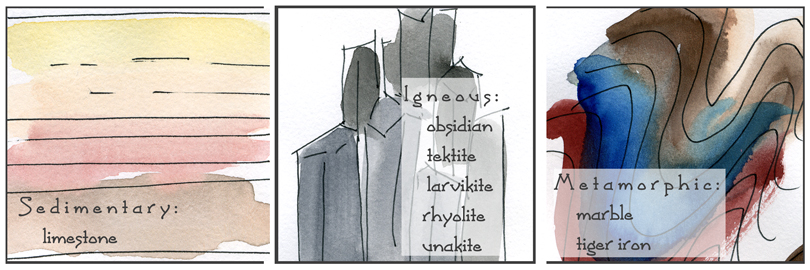
 Minerals are the basic building blocks for
all rocks, and most beads and other jewelry components sample areas of rock that are a single mineral. A mineral
may have a variety of elements present in its chemical composition, but it is the consistent organization of
that chemical composition that defines the mineral. A composite rock like larvikite or tiger iron includes
familiar minerals - labradorite or tiger eye - along with others, and the scale of the mineral mixing is
such that the resulting bead is a combination of minerals - a rock - rather than a mineral. For a stone
like larvikite, the scale is human-sized: we can see coarse grain structure. For other stones, it's not as
easy to distinguish; marble (a granular metamorphic rock) may easily resemble jasper or agate (microcrystalline
quartz). In such cases, we rely on the properties of the stones.
Rock or mineral, each is one of the basic rock types: sedimentary, igeneous or metamorphic.
Each represents
a stage of the rock life cycle; igneous rock begins as magma that either solidifies underground forming intrusive
rocks like granite or flows and cools on the surface creating extrusive rocks like basalt. Rapidly cooling
lava can form obsidian (smooth glass-like stone) and rhyolite, and slower intrusive cooling creates coarser-grained granites
like unakite and larvikite. Exposed rocks are weathered
by wind and rain, and the deposits of rock and organic material like shell and bone that are laid down in layers
create sedimentary rocks. Limestone is a sedimentary rock made primarily of calcite.
Metamorphic rocks occur when existing rocks (igneous or sedimentary) are subjected
to high temperature and/or pressure which alters the mineralogical composition, texture and internal structure.
Marble is metamorphized limestone, and tiger iron is metamorphized tiger eye, jasper and hematite.
Stones in the jewelry items shown here are classified as "rocks" rather than a dominant
"mineral" so they are grouped by their rock type instead.
Minerals are the basic building blocks for
all rocks, and most beads and other jewelry components sample areas of rock that are a single mineral. A mineral
may have a variety of elements present in its chemical composition, but it is the consistent organization of
that chemical composition that defines the mineral. A composite rock like larvikite or tiger iron includes
familiar minerals - labradorite or tiger eye - along with others, and the scale of the mineral mixing is
such that the resulting bead is a combination of minerals - a rock - rather than a mineral. For a stone
like larvikite, the scale is human-sized: we can see coarse grain structure. For other stones, it's not as
easy to distinguish; marble (a granular metamorphic rock) may easily resemble jasper or agate (microcrystalline
quartz). In such cases, we rely on the properties of the stones.
Rock or mineral, each is one of the basic rock types: sedimentary, igeneous or metamorphic.
Each represents
a stage of the rock life cycle; igneous rock begins as magma that either solidifies underground forming intrusive
rocks like granite or flows and cools on the surface creating extrusive rocks like basalt. Rapidly cooling
lava can form obsidian (smooth glass-like stone) and rhyolite, and slower intrusive cooling creates coarser-grained granites
like unakite and larvikite. Exposed rocks are weathered
by wind and rain, and the deposits of rock and organic material like shell and bone that are laid down in layers
create sedimentary rocks. Limestone is a sedimentary rock made primarily of calcite.
Metamorphic rocks occur when existing rocks (igneous or sedimentary) are subjected
to high temperature and/or pressure which alters the mineralogical composition, texture and internal structure.
Marble is metamorphized limestone, and tiger iron is metamorphized tiger eye, jasper and hematite.
Stones in the jewelry items shown here are classified as "rocks" rather than a dominant
"mineral" so they are grouped by their rock type instead.
Sedimentary rocks make up between 80% and 90% of rock exposed on the Earth's surface. Sedimentary rocks begin as the by products of weathering - either physical weathering by ice, wind, rain and snow or chemical weathering though exposure to highly acidic or alkaline environments. Lithification is the process of binding loose sediment together through a cementing agent. Sometimes the cementing agent is the sediment itself, given sufficient time and pressure. Rock salt is a sedimentary rock that occurs in beds that are mined to produce table salt. Sedimentary rocks tend to be soft which makes them impractical for use in jewelry. Limestone and landscape stone are examples of sedimentary rocks available in bead form. Chalk is a fine-grained limestone and often dyed and stabilized to create economical "chalk turquoise" components.
Properties of igneous rocks depends largely on how the magma cooled and the degree of silica content. Extrusive rock forms on the Earth's surface and are known as volcanic rocks. Obsidian, basalt and rhyolite are examples of extrusive rock formed from lavas. Like obsidian, tektite is molten rock rapidly cooled as glass, but it forms under different conditions, as ejecta from meteor impacts. Larvikite comes from the Larvik batholith in Norway formed from a group of intrusive rock solidifying deep under the surface. Larvikite is called "blue labradorite" due to the high schiller effect in the stone from large feldspar content. Unakite is a kind of granite comprised of pink feldspar and epidote (dark forest green mineral) that was first discovered in Unakas mountains of North Carolina.
Metamorphic rocks result from dynamic pressure (like from tectonic plates colliding and one forced under the other), thermal contact (proximity to hot spot), or regional change (tectonic plates colliding and one being uplifted by the other). Marble is the most common metamorphic rock in jewelry components, and it takes its names and colors from the mineral impurities embedded in the limestone that is subjected to metamorphic change. Pure marble is white. Tiger iron is a strongly colored banded stone made of tiger eye, jasper and hematite.